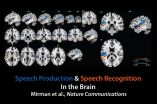(Press-News.org) A new study is a rare look into the delicate dynamics of social movement, and shows how people avoid bumping into each other while doing complementary, coordinated tasks such as dancing. The research reveals that people fall into a specific pattern to avoid a collision. The study led by Michael J. Richardson, a University of Cincinnati associate professor of psychology, is published in the highly ranked Journal of Experimental Psychology: Human Perception and Performance, a journal of the American Psychological Association.
The study involved 12 pairs of two participants simultaneously moving objects on a 50-inch computer screen from one location to another - without bumping their objects into each other - using a hand-held motion-tracking sensor to control their movements. The virtual tasks included moving a dot on the computer screen from bottom-left to top-right for one participant and bottom-right to top-left for the partnering participant.
"This task was chosen because many joint actions involve the continuous production of repetitive movements over time," write the authors. "For instance, the same or similar movements are performed in a repetitive manner when two individuals are loading a dishwasher, stacking a pile of blocks or magazines, or dancing or (Kung Fu) fighting together. These social activities, however, do not involve the incidental inphase or antiphase movement synchronization that has been the focus of previous studies of social coordination. On the contrary, they require that individuals explicitly avoid colliding into each other and establish a more complex or complementary pattern of movement coordination - since prototypical inphase or antiphase patterns of movement coordination would result in task failure."
While no specific instructions were given to participants on how to coordinate their movements, the experiment found that nearly all of the pairs fell into the same stable pattern of coordination, with one participant adopting a more straight-line trajectory between the targets, and the partner falling into a more elliptical trajectory between the targets. "Of particular significance, task success was dependent on the participants discovering this complementary task solution," the authors explain.
All 24 participants were college undergraduates and were right-handed. The pairs stood back to back while performing the tasks. They could not see each other, but they could see their partner's virtual dot movement on the screen. A Polhemus FASTRACK magnetic motion tracking system recorded and tracked the movements of each participant.
The researchers reported a total of 164 successful trials completed by the pairs. On average, the 11 pairs retained for analysis took 21 trials to reach a score of 15.
Richardson explains that as researchers make strides in understanding the coordination of interpersonal movement, then these discoveries could support research in areas ranging from the social coordination of children with autism, people with schizophrenia, human interaction with robotics and sport rehabilitation.
"Once you gain an understanding of normative dynamics, we can better diagnose when those dynamics are not working properly and also design interventions," explains Richardson. "We've developed a dynamic model that captures the behavioral dynamics as well as provides a theoretical explanation of why certain behavior emerges between people as they learn to avoid each other while performing certain tasks."
INFORMATION:
The research was conducted in the UC Department of Psychology's Center for Cognition, Action and Perception. Funding for the study was supported by a $1.4 million grant from the National Institutes of Health awarded to the UC Department of Psychology in 2013. The five-year grant supports the development of computerized models to examine how social interaction and movement influence each other.
Co-authors on the paper are Steven Harrison, a research associate for the University of Nebraska Omaha; Rachel Kallen, a UC assistant professor of psychology; Ashley Walton, a UC doctoral student in psychology; Brian Eiler, a UC doctoral student in psychology; Elliott Saltzman, a professor in the Department of Physical Therapy at Boston University; and Richard Schmidt, a psychology professor at the College of the Holy Cross in Worcester, Massachusetts.
The exchange of words, speaking and listening in conversation, may seem unremarkable for most people, but communicating with others is a challenge for people who have aphasia, an impairment of language that often happens after stroke or other brain injury. Aphasia affects about 1 in 250 people, making it more common than Parkinson's Disease or cerebral palsy, and can make it difficult to return to work and to maintain social relationships. A new study published in the journal Nature Communications provides a detailed brain map of language impairments in aphasia following ...
Three or more hours of walking per week can boost the vitality and health of prostate cancer survivors. Men and women who have survived colorectal cancer and are regular walkers as well report lower sensations of burning, numbness, tingling or loss of reflexes that many often experience post-treatment. These are among the findings of two studies published in Springer's Journal of Cancer Survivorship that highlight the benefits of exercise for cancer survivors.
In the first, a group of American researchers led by Siobhan Phillips of Northwestern University weighed up the ...
One of the immune system's most critical challenges is to differentiate between itself and foreign invaders -- and the number of recognized autoimmune diseases, in which the body attacks itself, is on the rise. But humans are not the only organisms contending with "friendly fire."
Even single-celled bacteria attack their own DNA. What protects these bacteria, permitting them to survive the attacks?
A new study published in Nature by a team of researchers at Tel Aviv University and the Weizmann Institute of Science now reveals the precise mechanism that bacteria's defense ...
(PHILADELPHIA) - As cesarean section rates continue to climb in the United States, researchers are looking to understand the factors that might contribute. There has been debate in the field about whether non-medically required induction of labor leads to a greater likelihood of C-section, with some studies showing an association and others demonstrating that inductions at full term can actually protect both the mothers and babies. In order to tease apart the evidence, a new analysis pooled the results from five randomized controlled trials including 844 women, and found ...
Berkeley - A new study quantifying the amount of carbon stored and released through California forests and wildlands finds that wildfires and deforestation are contributing more than expected to the state's greenhouse gas emissions.
The findings, published online today (Wednesday, April 15), in the journal Forest Ecology and Management, came from a collaborative project led by the National Park Service and the University of California, Berkeley. The results could have implications for California's efforts to meet goals mandated by the state Global Warming Solutions Act, ...
Researchers at the Angiocardioneurology Department of the Neuromed Scientific Institute for Research, Hospitalisation and Health Care of Pozzilli (Italy), have found, in animal models, that the absence of a certain enzyme causes a syndrome resembling the Attention Deficit Hyperactivity Disorder (ADHD). The study, published in the international journal EMBO Molecular Medicine, paves the way for a greater understanding of this childhood and adolescent disease, aiming at innovative therapeutic approaches.
Described for the first time in 1845, but came to the fore only in ...
HEIDELBERG, 15 April 2015 - A genetic investigation of individuals in the Framingham Heart Study may prove useful to identify novel targets for the prevention or treatment of high blood pressure. The study, which takes a close look at networks of blood pressure-related genes, is published in the journal Molecular Systems Biology.
More than one billion people worldwide suffer from high blood pressure and this contributes significantly to deaths from cardiovascular disease. It is hoped that advances in understanding the genetic basis of how blood pressure is regulated ...
Philadelphia, PA, April 16, 2015 - About 15% of patients with Lyme disease develop peripheral and central nervous system involvement, often accompanied by debilitating and painful symptoms. New research indicates that inflammation plays a causal role in the array of neurologic changes associated with Lyme disease, according to a study published in The American Journal of Pathology. The investigators at the Tulane National Primate Research Center and Louisiana State University Health Sciences Center also showed that the anti-inflammatory drug dexamethasone prevents many ...
New York, NY--While a large number of women quit or reduce smoking upon pregnancy recognition, many resume smoking postpartum. Previous research has estimated that approximately 70% of women who quit smoking during pregnancy relapse within the first year after childbirth, and of those who relapse, 67% resume smoking by three months, and up to 90% by six months.
A new study out in the Nicotine & Tobacco Research indicates the only significant predictor in change in smoking behaviors for women who smoked during pregnancy was in those who breastfed their infant, finding ...
Children who are taught about preventing sexual abuse at school are more likely than others to tell an adult if they had, or were actually experiencing sexual abuse. This is according to the results of a new Cochrane review published in the Cochrane Library today. However, the review's authors say that more research is needed to establish whether school-based programmes intended to prevent sexual abuse actually reduce the incidence of abuse.
It is estimated that, worldwide, at least 1 in 10 girls and 1 in 20 boys experience some form of sexual abuse in childhood. Those ...

